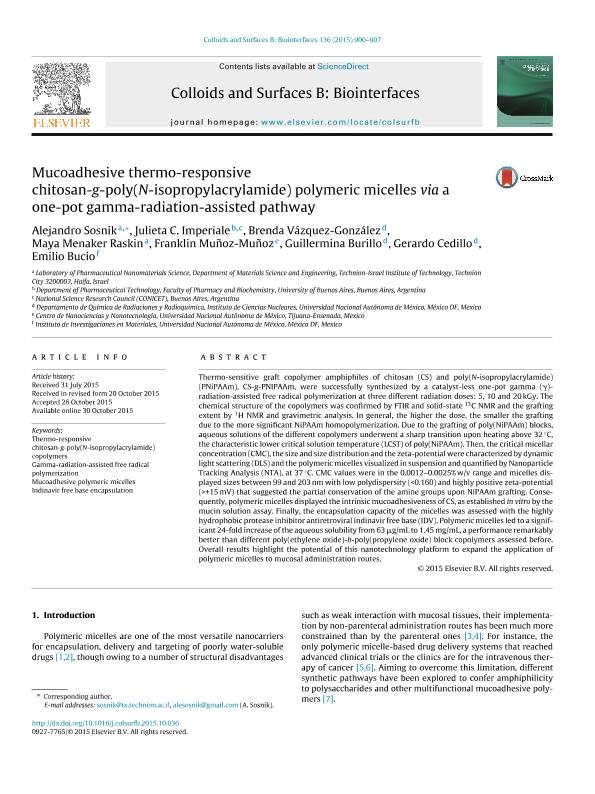Mostrar el registro sencillo del ítem
dc.contributor.author
Sosnik, Alejandro Dario

dc.contributor.author
Imperiale, Julieta Celeste

dc.contributor.author
Vázquez González, Brenda
dc.contributor.author
Raskin, Maya Menaker
dc.contributor.author
Muñoz Muñoz, Franklin
dc.contributor.author
Burillo, Guillermina
dc.contributor.author
Cedillo, Gerardo
dc.contributor.author
Bucio, Emilio
dc.date.available
2018-09-17T17:47:56Z
dc.date.issued
2015-12
dc.identifier.citation
Sosnik, Alejandro Dario; Imperiale, Julieta Celeste; Vázquez González, Brenda; Raskin, Maya Menaker; Muñoz Muñoz, Franklin; et al.; Mucoadhesive thermo-responsive chitosan-g-poly(N-isopropylacrylamide) polymeric micelles via a one-pot gamma-radiation-assisted pathway; Elsevier Science; Colloids and Surfaces B: Biointerfaces; 136; 12-2015; 900-907
dc.identifier.issn
0927-7765
dc.identifier.uri
http://hdl.handle.net/11336/59903
dc.description.abstract
Thermo-sensitive graft copolymer amphiphiles of chitosan (CS) and poly(N-isopropylacrylamide) (PNiPAAm), CS-g-PNIPAAm, were successfully synthesized by a catalyst-less one-pot gamma (γ)-radiation-assisted free radical polymerization at three different radiation doses: 5, 10 and 20kGy. The chemical structure of the copolymers was confirmed by FTIR and solid-state 13C NMR and the grafting extent by 1H NMR and gravimetric analysis. In general, the higher the dose, the smaller the grafting due to the more significant NiPAAm homopolymerization. Due to the grafting of poly(NiPAAm) blocks, aqueous solutions of the different copolymers underwent a sharp transition upon heating above 32°C, the characteristic lower critical solution temperature (LCST) of poly(NiPAAm). Then, the critical micellar concentration (CMC), the size and size distribution and the zeta-potential were characterized by dynamic light scattering (DLS) and the polymeric micelles visualized in suspension and quantified by Nanoparticle Tracking Analysis (NTA), at 37°C. CMC values were in the 0.0012-0.0025%w/v range and micelles displayed sizes between 99 and 203nm with low polydispersity (<0.160) and highly positive zeta-potential (>+15mV) that suggested the partial conservation of the amine groups upon NiPAAm grafting. Consequently, polymeric micelles displayed the intrinsic mucoadhesiveness of CS, as established in vitro by the mucin solution assay. Finally, the encapsulation capacity of the micelles was assessed with the highly hydrophobic protease inhibitor antiretroviral indinavir free base (IDV). Polymeric micelles led to a significant 24-fold increase of the aqueous solubility from 63μg/mL to 1.45mg/mL, a performance remarkably better than different poly(ethylene oxide)-b-poly(propylene oxide) block copolymers assessed before. Overall results highlight the potential of this nanotechnology platform to expand the application of polymeric micelles to mucosal administration routes.
dc.format
application/pdf
dc.language.iso
eng
dc.publisher
Elsevier Science

dc.rights
info:eu-repo/semantics/openAccess
dc.rights.uri
https://creativecommons.org/licenses/by-nc-nd/2.5/ar/
dc.subject
Gamma-Radiation-Assisted Free Radical Polymerization
dc.subject
Indinavir Free Base Encapsulation
dc.subject
Mucoadhesive Polymeric Micelles
dc.subject
Thermo-Responsive Chitosan-G-Poly(N-Isopropylacrylamide) Copolymers
dc.subject.classification
Nano-materiales

dc.subject.classification
Nanotecnología

dc.subject.classification
INGENIERÍAS Y TECNOLOGÍAS

dc.title
Mucoadhesive thermo-responsive chitosan-g-poly(N-isopropylacrylamide) polymeric micelles via a one-pot gamma-radiation-assisted pathway
dc.type
info:eu-repo/semantics/article
dc.type
info:ar-repo/semantics/artículo
dc.type
info:eu-repo/semantics/publishedVersion
dc.date.updated
2018-09-13T13:13:31Z
dc.journal.volume
136
dc.journal.pagination
900-907
dc.journal.pais
Países Bajos

dc.journal.ciudad
Amsterdam
dc.description.fil
Fil: Sosnik, Alejandro Dario. Technion - Israel Institute of Technology; Israel. Consejo Nacional de Investigaciones Científicas y Técnicas; Argentina
dc.description.fil
Fil: Imperiale, Julieta Celeste. Universidad de Buenos Aires. Facultad de Farmacia y Bioquímica. Departamento de Tecnología Farmacéutica; Argentina. Consejo Nacional de Investigaciones Científicas y Técnicas; Argentina
dc.description.fil
Fil: Vázquez González, Brenda. Universidad Nacional Autónoma de México; México
dc.description.fil
Fil: Raskin, Maya Menaker. Technion - Israel Institute of Technology; Israel
dc.description.fil
Fil: Muñoz Muñoz, Franklin. Universidad Nacional Autónoma de México; México
dc.description.fil
Fil: Burillo, Guillermina. Universidad Nacional Autónoma de México; México
dc.description.fil
Fil: Cedillo, Gerardo. Universidad Nacional Autónoma de México; México
dc.description.fil
Fil: Bucio, Emilio. Universidad Nacional Autónoma de México; México
dc.journal.title
Colloids and Surfaces B: Biointerfaces

dc.relation.alternativeid
info:eu-repo/semantics/altIdentifier/doi/http://dx.doi.org/10.1016/j.colsurfb.2015.10.036
dc.relation.alternativeid
info:eu-repo/semantics/altIdentifier/url/https://www.sciencedirect.com/science/article/pii/S0927776515302678
Archivos asociados
